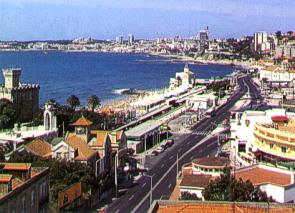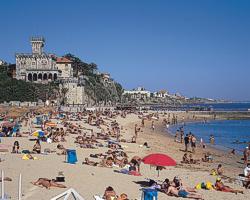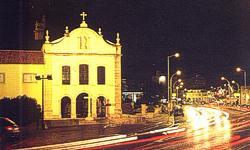
PORTUGUÊS
Depois de reconquistarem a terra ao Mouros em 1147, o povo de
Cascais passou-se a dedicar à pesca. Pensa-se que o nome Cascais
tenha vindo da palavra "cascas", que significa conchas,
referindo-se, provavelmente, aos montes de conchas do mar vazias.
Esta ligação ao mar deu aos seus habitantes, a oportunidade de
pedir e de ter uma resposta favorável em relação ao privilégio de
ter o seu próprio governo, acabando desta forma com a sua ligação a
Sintra.
Em 1364, o Rei Pedro I concedeu a Cascais o título de município,
mas só entrou em vigor em 1370 quando o Rei Fernando deu o castelo
a Gomes Lourenço de Avelar. A partir de então, Cascais passou a
servir de apoio a Lisboa durante a época das grandes descobertas
marítimas. Era o primeiro terra que os navegadores viam quando
regressavam, em busca da sua terra natal, das longas viagens de
aventuras, e o última quando partiam à procura dos tesouros
africanos, das especiarias do oriente, do açúcar e do ouro do
Brasil. Foi por isso, que na época do Rei Manuel I, em meados do
século XVI, quando as descobertas portuguesas atingiram o auge, que
Cascais foi um dos primeiros locais a ter um farol. Estava situado
exactamente no mesmo local onde se situa hoje o farol da Guia. A
baía tem uma localização estratégica de grande importância. Foi lá
que, em 1560, o Duque de Alba, ao serviço do Rei Filipe II de
Espanha, desembarcou para conquistar Portugal. A intenção do Rei
Filipe era a de trazer a corte para Lisboa e governar as duas
monarquias a partir de cá. Muito foi escrito por Nicolau de
Oliveira sobre o clima ameno de Cascais e da longa vida do seu
povo. Sofrendo com o domínio da Espanha, o povo de Cascais
participou activamente na restauração da independência de Portugal
e desde 1640, construíram muitas fortalezas, ao longo da costa, que
ainda hoje são utilizadas para uma grande variedade de coisas.

O famoso terramoto do dia 1 de Novembro de 1755, destruiu uma
grande parte de Lisboa e interrompeu a prosperidade de Cascais,
arruinando casas, igrejas.
Durante as guerras Napoleónicas, Cascais permaneceu neutro e
Junot, o comandante da primeira invasão, instalou a sua base na
cidade. Em 1808, ele foi forçado a assinar a sua rendição. O 19º
regimento de infantaria, sobre a protecção divina de Santo António,
partiu da Cidadela em 1810 para a batalha decisiva contra Napoleão
- a Batalha do Bucaço. A estátua de Santo António na Cidadela ainda
continua a ser venerada. Foi em Cascais, durante os últimos anos do
século XIX, que a Família Real começou e ir à praia. Era um costume
que se tornara muito popular por toda a Europa, e Cascais, devido
ao seu clima ameno, era o local ideal.

Ao longo dos anos, muitas famílias importantes fizeram de
Cascais uma cidade cosmopolita, construindo palácios, trabalhando
em azulejos e em outras artes interessantes. Foi durante este
período que Lisboa teve as suas primeiras iluminações eléctricas
públicas e o seu primeiro telefone. Desde 1930 que, quer Cascais
quer o Monte Estoril têm mantido a Costa do Estoril como o
ex-libris do turismo em Portugal. Esta área era conhecida,
inicialmente, como a Costa do Sol, mas actualmente, é conhecida
como Costa do Estoril. Têm sido construídos, ao longo dos anos,
novos edifícios para responder à cada vez maior procura por parte
dos turistas. Ao longo de todo o ano, Cascais proporciona, aos
turistas, todas as condições de que necessitam, enquanto que a
população local continua com a sua vida.
Uma das partes mais bonitas da Costa do Estoril é o campo - uma
sucessão de serras cobertas de pinheiros e casas, descendo em
direcção ao mar. Além dos cenários normais do campo, o turista
também gostará de ver as aldeias locais com as suas casas típicas e
as velhas quintas à beira mar. As visitas dependem do tempo
disponível e dos gostos de cada um

A CACHE
Esta micro cache é de fácil acesso, situada num local bastante
conhecido do Estoril, pode ser dificil procurar a cache sem ser
visto, mas com sorte ninguem vai reparar em mais um !!! o melhor é
ler atentamente as ajudas, para não levantar muita suspeita !!!
Espero que goste , aproveite e vá até á Muralha passear, não há que
enganar, é sempre para sul em direcção ao mar !
INGLÊS
Because of its mediterranean climate, the Costa do Estoril
(Estoril Coast) has soft winters and the summers have an ideal
temperature, that never gets too high. The autumn is also ideal,
like a second spring. It starts in Carcavelos, just 15 kms from
Lisbon, and goes all the way till Guincho, offering a perfect
combination between the pleasures of the land and the fascinating
beauty of the sea. After regaining the land from the Moors in 1147,
the people of Cascais started to live off fishing. The name
`Cascais' is believed to have derived from the word `cascas', that
means `shells', which is probably referring to the lots of empty
sea shells found. This connection with the sea gave its people the
opportunity to ask for its own leadership; this was given and so it
lost its connection with Sintra.
In 1364, King Pedro I gave Cascais the title of `município', but
it only became official in 1370 when King Fernando gave the castle
to Gomes Lourenço de Avelar. From then on, Cascais started to serve
Lisbon during the time of the great maritime discoveries. It was
the first piece of land that the navigators saw when heading back
from the seas, in search of their home land, from the long
adventures, and the last they saw when heading for the African
treasures, the Indian spices or the sugar and gold from Brasil.
That's why, in the time of King Manuel I, around the 16th century,
when the Portuguese discoveries reached their highest point,
Cascais was one of the first cities to have a lighthouse. It was at
the exact place where today stands the Guia lighthouse. The bay has
a strategic location of great importance. It was there, in 1560,
that Duque de Alba, working for King Filipe II of Spain, set to
conquer Portugal. King Filipe wanted to come to Lisbon and rule the
two monarquies from here. A lot has been written by Nicolau de
Oliveira about the moderate climate and the longevity of the people
of Cascais. Suffering with the Spanish occupation, the people of
Cascais was very active in the fight to regain independence and,
since 1640, they built a lot of fortresses, along the coast, which
today are still used for a variety of purposes. The famous
earthquake of November 1st, 1755, destroyed a great part of Lisbon
and interrupted the prosperity of Cascais, bringing down houses and
churches.
During the Napoleonic wars, Cascais maintained itself neutral
and Junot, the commander of the first invasion, set his base in the
city. In 1808, he was forced to sign his rendition. The 19th
regiment of the infantry, under the divine protection of Santo
António, parted from the city in 1810 towards the decisive battle
against Napoleão, the battle of Buçaco. The statue of Santo António
in the city is still worshiped. It was in Cascais, by the end of
the 19th century, that the royal family started to go to the beach.
It was a tradition that became common all over Europe, and also in
Cascais, because of its climate.
Through the years, lots of imporant families made of Cascais a
cosmopolitan city, building palaces, working in hand painted tiles
(azulejos) and other interesting arts. It was during this period
that Lisbon had the first public lighting and telephone. Since
1930, both Cascais and Monte Estoril have maintained the Cascais
coast as the ex- libiris of Portuguese tourism. This area was first
known as Costa do Sol (Sun's Coast) but today it is known as Costa
do Estoril (Estoril's Coast). Several new buildings have been
raised through the years to face the increasing demand of tourism.
All year round, Cascais provides its tourists with everything they
need and the locals go on with their lives.
One of the most beautiful parts of Costa do Estoril is the land
– a succession of mountains covered with pinetrees and houses, all
the way till the sea. The tourist will also like to see the local
villages and its typical houses, as well as the old farms along the
coast. Visits will be dependant upon available time and personal
taste.
THE CACHE
This micro-cache has a very easy access and is situated in a
well known part of Estoril. It may be hard to search for the cache
without being seen, but with luck nobody will notice one more
person in the area. You are advised to read the hints so that you
can hunt the cache without being noticed. I hope you like it! Take
the chance and walk in the Muralha, all the way south facing the
sea!